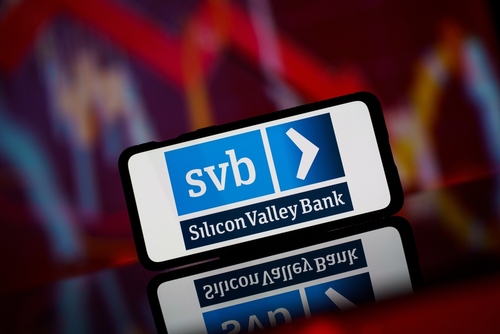Is Your Money Safe?
Reflections on the SVB Collapse, and What to Do About It

Most of us were taught as children that a bank is the safest place to put our money. The interest rates may be pitiful, there’s no protection from inflation … but by golly, you can sleep soundly knowing that the money you put in your bank account yesterday will still be there in the morning. With recent financial news it is worth asking “Is Your Money Safe?”.
But what if we woke up one morning to discover that this was no longer the case?
The recent collapse of Silicon Valley Bank (SVB) has raised concerns about the stability of the entire banking system. Founded in 1982, SVB became the go-to bank for entrepreneurs and startups. Why not? “Silicon Valley” is right there in the name! It’s the cradle of digital-age innovation. Who wouldn’t want the good luck charm of an SVB bank account?
Then 2020 happened. Among other things, interest rates were reduced to zero and stimulus money flooded the economy. Banks and individuals had a problem that you would never in a million years think of as a problem — too much money.
How Does A Bank Fail Because Of “Too Much Money?”
What does that even mean? How does “too much money” add up to disaster?
US banks operate on a principle called “fractional reserve banking.” Under this principle, a bank is required to keep cash in reserve … but not every dollar on their deposit books. They only have to keep a fraction of the grand total of customer deposits on hand.
The Federal Reserve sets what that reserve fraction will be. Let’s say they set it at 10%. If bank customers have a total of $100 million on deposit with that bank, the bank is only required to keep $10 million in cash on hand at any given time.
That’s why a “run on a bank” is so dangerous. If every customer somehow showed up on the same day and demanded their money back, the bank simply would not have it.
Well, buckle up … in March 2020, the Federal Reserve reduced the reserve requirement to 0%. Banks no longer had to keep any percentage of their deposits as cash-on-hand … leaving them free to lend it out and invest it as they saw fit.
How did SVB use that freedom? It invested heavily in government-backed bonds with a significant portion locked away for three to four years at an interest rate of just 1.79%.
See the problem? When high interest rates and inflation hit, those investments immediately revealed themselves to be losers. Who wants to be holding 1.79% bonds in a 7% interest rate environment and an inflation environment of nearly 8%?
At the same time, SVB’s biggest customers — the tech companies — saw their revenues take a hit due to the exact same economic forces. At a key moment, SVB found itself unable to raise capital, and Federal regulators stepped in and shut the bank down.
Will SVB Customers Get Their Money Back?
So what happens to all the money on deposit at SVB, with little or no fractional reserve requirement to cover it? It’s FDIC-insured, right? The government will pay. Right?
Actually, wrong. FDIC only insures balances up to $250,000. Only 2.7% of SVB’s deposits are less than $250,000, meaning 97.3% of their money is not FDIC insured, leaving the fate of that money uncertain.
Now, the Federal government has stepped in to guarantee 100% of depositors’ funds in the SVB debacle … but if they hadn’t, customers with more than $250k on deposit would be stuck waiting to recover their money in a bankruptcy court, a process that could take years and result in only partial restitution.
Is This an SVB Problem, or an Everyone Problem?
Everyone, potentially. The SVB failure could ripple through other banks and companies, as it was a major bank for venture-backed companies in the US. With over $342 billion worth of customer funds held by SVB, the collapse could cripple many businesses that relied on these funds for growth.
And if more banks fail, who knows if the Federal government will be able to guarantee all the affected deposits. There’s only so much money in the US Treasury, and our national credit card is already overtaxed.
So if banks aren’t safe … what now?
If you’re scared, I don’t blame you. What do you do with your money if you can’t trust a bank of all places?
Here’s what to consider:
Don’t keep more than $250,000 in any single bank. As long as your deposits in each bank are under $250,000, you still have FDIC insurance (for what it’s worth).
Choose larger, more diversified banks. Will FDIC insurance always save you? Better question — wouldn’t it be nice not to have to find out? Give yourself that peace of mind by choosing a bank that is less likely to fail due to more sound reserve and investment policies.
Diversify your own assets! In this era of high inflation, consider shifting from cash to real assets — like cash-flowing real estate. The US has a strong history of defending property rights, and with a real asset like rental property, you have the security of owning a scarce, in-demand resource that will rise with inflation, rather than lag behind it like cash.
If you’re ready to take some of your money out of the wobbly banking system and put it into cash-flowing, inflation-resistant property, it doesn’t have to be difficult — MartelTurnkey has you covered. We constantly replenish our inventory of cash-flowing rental real estate available for our turkey investors.
Click here to see what properties we currently have available.
Click here to watch Eric Martel’s YouTube video on this topic.
Want to take some cash out of the struggling system and quickly transition it into something real? Reach out to us today!